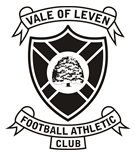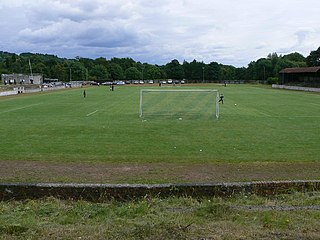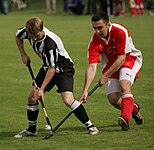Original club
In the early days of Scottish football, Vale of Leven (based in Alexandria) and their neighbours Renton were real powers in the land, thanks to significant backing from local factories; Vale was backed by Archibald Orr-Ewing's dye works, which meant that Vale could recruit players as factory workers but allow them the time and facilities to play football. [2]
One early controversy over this veiled professionalism came in the 1874–75 Scottish Cup. The club was drawn against Clydesdale F.C. in the first round; the Glaswegian club protested the presence in the Vale side of John Ferguson, who, as a former professional athlete, was barred from playing in the competition at the time, [3] even though Ferguson was described as an amateur who "usually wrought in the Vale of Leven from year to year, and no objection was made to him in the international match"; [4] the tie was played under protest, and, after a goalless draw, Vale withdrew rather than re-play.
The rule was changed for the next season and Vale promptly reached the semi-final, and then won the Cup three times in succession (1877, 1878 and 1879). In 1878 they travelled down to England and beat the FA Cup winners, The Wanderers, 3–1 at Kennington Oval. The Wanderers had the advantage that the game was played under the English throw-in rule, [5] but the Vale's Scottish passing game proved superior to the English game of individual dribbling. [6] [7] The club also won the Glasgow Celtic Society Cup in shinty in 1879.
Vale of Leven was a founder member of the Scottish Football League when it was formed in 1890. By this time, the club was being eclipsed by the rising stars of well-supported clubs based in Glasgow, and local rivals Dumbarton. In their second season, they failed to win a single game and finished last, being the last senior Scottish club to suffer this ignominy until Brechin in 2018. Rather than face re-election for the second time, the club withdrew and joined the rival Scottish Alliance where they played for a single season.
Between 1893 and 1902, the Vale played only friendly matches and in cup competition before joining the Scottish Football Combination. In 1905, they applied successfully for readmission to the Scottish League when Division Two was expanded for two additional teams. They finished as runners-up in 1907 and in 1909, but did not receive the votes they needed to be elected to Division One. As the following decade wore on, Vale of Leven struggled and regularly finished near the foot of the table. When Division Two was suspended in 1915, Vale joined the Western League.
After World War I ended, Vale of Leven returned to the Scottish League for the third time as members of the reformed Division Two. After a decent fourth-place finish in their first season, the club was relegated to the new Division Three in 1924, but this ill-fated competition was shut down in 1926 and that year's championship withheld after it became clear that the costs of meeting match guarantees and travel and other expenses were beyond the capacity of its member clubs to pay.
After a season playing in the Scottish Alliance, financial constraints forced the club into a local district league before being discontinued in 1929, victims of the Great Depression which had proven so disastrous for many small Scottish football clubs at professional and amateur level. There was every intention of reviving the club once local economics made it viable; however, unlike previous occasions, they were struck off the SFA club roll after withdrawing from their Scottish Qualifying Cup match against Dykehead.




